Unlocking App Insights: Choosing the Right React Native Analytics Tool
Building a successful React Native app requires understanding user behavior. This curated list of the top 8 React Native analytics tools will help you choose the right platform for your needs in 2025. Discover how these tools provide crucial insights into app performance, user engagement, and potential issues, enabling data-driven decisions for growth. From CodePushGo to industry giants like Google Firebase and Adobe Analytics, we cover the key players in React Native analytics, empowering you to make the best choice for your project.
1. CodePushGo
CodePushGo offers React Native developers a robust and secure platform to streamline app updates, enhance user experience, and gain valuable insights into update performance. It addresses a critical pain point for mobile developers: the often lengthy app store review process. By enabling instant over-the-air (OTA) updates, CodePushGo bypasses these delays, allowing developers to push critical bug fixes, new features, and performance enhancements directly to users in minutes, keeping apps fresh and responsive to user needs. This agility is crucial in today’s fast-paced mobile landscape where users expect seamless experiences and rapid issue resolution. Moreover, CodePushGo prioritizes security with true end-to-end encryption, ensuring that sensitive code changes are protected throughout the update process. This feature is particularly important for organizations handling sensitive data and prioritizing user privacy.

Beyond speed and security, CodePushGo provides a wealth of features designed to optimize the entire update workflow. Smart differential updates minimize bandwidth usage by downloading only the changed code, resulting in smaller update sizes and faster downloads for users. Integrated real-time analytics provide crucial insights into update success rates, user engagement, and potential issues, empowering teams to make data-driven decisions. Learn more about CodePushGo and how it facilitates automatic app updates. The platform’s one-click rollback feature allows for quick recovery in case of unforeseen problems, minimizing user disruption.
CodePushGo’s flexible deployment options cater to various team needs and infrastructure setups. Developers can choose between cloud-hosted or self-hosted solutions, providing control and customization. Seamless integration with popular CI/CD pipelines like GitHub Actions and Jenkins automates the update process, streamlining workflows and reducing manual intervention. A powerful public API further extends flexibility, allowing developers to create custom integrations and workflows tailored to their specific requirements. This adaptability makes CodePushGo suitable for a wide range of development teams, from small startups to large enterprises.
For managing releases, CodePushGo offers a channel-based system that supports staged rollouts and targeted beta testing. This allows developers to test new features with specific user groups before releasing them to the wider audience, mitigating risks and gathering valuable feedback. Granular user management facilitates team collaboration, ensuring efficient workflow management and controlled access to sensitive update functionalities.
While CodePushGo offers significant advantages, it’s important to consider the potential drawbacks. The initial CI/CD setup involves a one-time fee of $2,600, which might be a barrier for smaller teams or projects with limited budgets, although the long-term cost savings can be substantial. Another limitation is its exclusive focus on React Native. Teams working with other development frameworks will need to explore alternative solutions.
CodePushGo’s strengths lie in its ability to deliver instant, compliant OTA updates that bypass app store review delays, combined with robust security features and comprehensive analytics. Its flexible hosting options, CI/CD integrations, and powerful API offer significant customization and adaptability. These features make CodePushGo a valuable tool for React Native developers, DevOps engineers, QA and beta testing teams, security-conscious organizations, and product managers seeking real-time insights into app update performance. It empowers teams to ship high-quality updates securely and efficiently, fostering a more agile and responsive development cycle. Its proven track record, with apps boasting over 20 million users and a 95% update rate within 24 hours, further solidifies its position as a leading solution for streamlined and secure React Native app updates. For teams prioritizing rapid iteration, user satisfaction, and robust security, CodePushGo deserves serious consideration.
2. Google Analytics for Firebase
Google Analytics for Firebase is a powerful and free analytics solution specifically designed for mobile applications, including those built with React Native. It provides valuable insights into app usage, user engagement, and overall app performance. This tool allows developers to understand how users interact with their app, identify areas for improvement, and ultimately enhance the user experience. Its seamless integration with other Firebase services makes it a comprehensive solution for React Native app analytics. This makes it an invaluable tool for React Native developers seeking a robust, free, and readily integrated analytics solution.
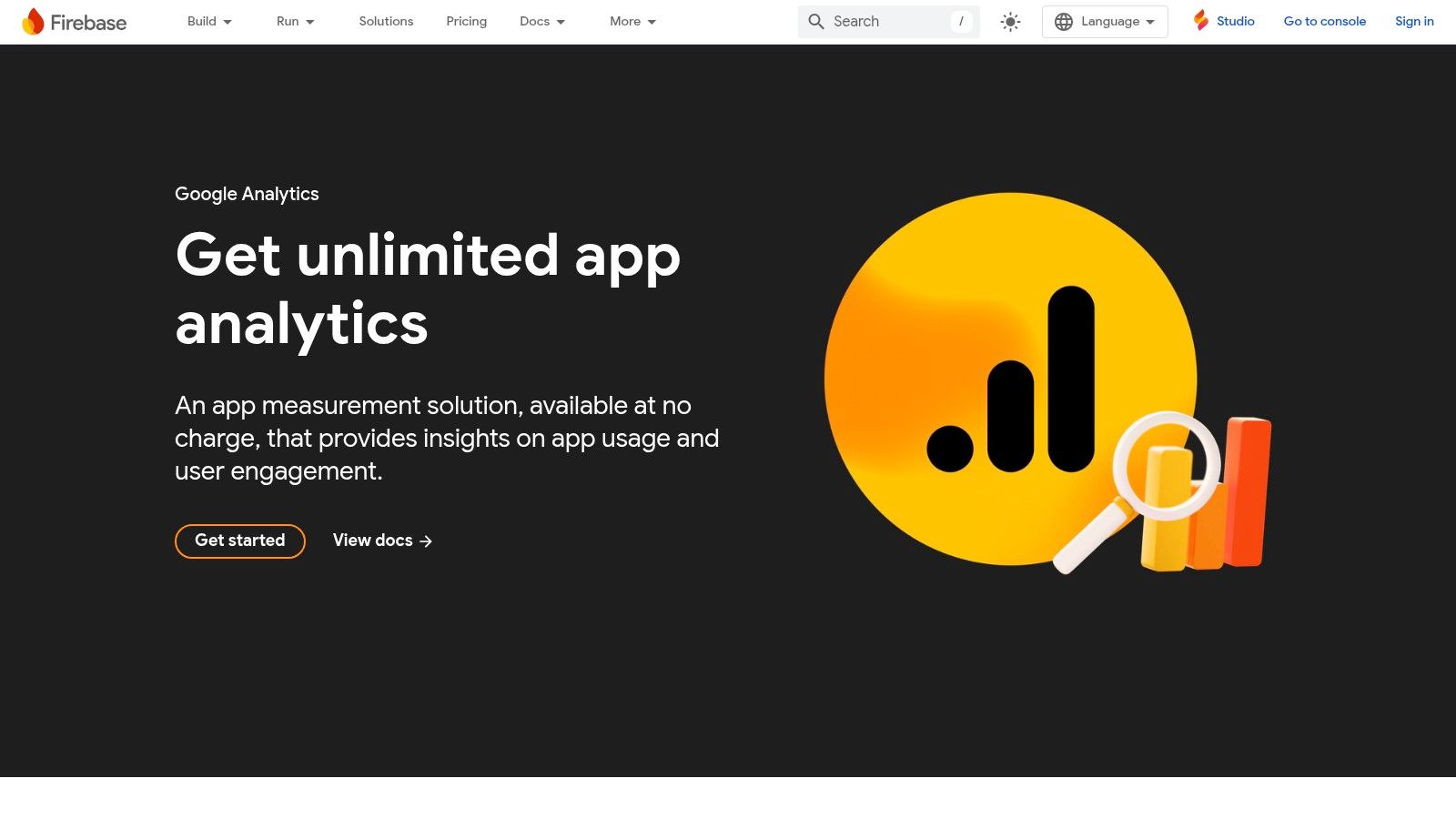
One of the key benefits of Firebase Analytics is its free tier, offering unlimited reporting on up to 500 distinct events. This generous allowance caters to the needs of most React Native developers, from indie developers working on small projects to larger teams managing complex applications. This removes any financial barrier to entry and allows teams of all sizes to benefit from sophisticated analytics. Real-time data processing and reporting are another standout feature. Developers can monitor key metrics as they happen, allowing for quick identification of trends, anomalies, and areas needing immediate attention. For example, a sudden drop in in-app purchases might signal a bug or usability issue that requires immediate investigation.
Firebase Analytics offers a suite of features designed to provide a holistic view of app performance. Automatic event tracking captures essential information such as app opens, in-app purchases, and crashes, providing a baseline understanding of user behavior without any additional coding. This automatic tracking frees up developers to focus on custom event tracking, allowing them to measure specific interactions relevant to their application’s unique features. For instance, an e-commerce app might track events like adding items to a cart, initiating checkout, or completing a purchase, providing granular insights into the user journey. Beyond event tracking, Firebase Analytics offers audience segmentation and funnel analysis. These tools allow developers to identify specific user groups based on their behavior and track their progress through predefined conversion funnels. This is crucial for optimizing user flows and improving conversion rates.
Integration with other Firebase services, like Crashlytics and Performance Monitoring, further enhances the value of Firebase Analytics. This tight integration provides a comprehensive view of app health, from user behavior and engagement to crash reports and performance bottlenecks. For instance, by combining user engagement data with crash reports, developers can identify which user actions might be triggering crashes, leading to faster bug resolution and improved app stability.
Implementation and Setup Tips:
Setting up Firebase Analytics in a React Native project is relatively straightforward. It involves installing the necessary Firebase SDK packages, configuring the Firebase project in the console, and initializing the SDK in the app’s entry point. Detailed instructions can be found in the official Firebase documentation. A crucial step is to carefully plan the custom events you want to track. Identify key user actions and define clear event names and parameters to ensure consistent and meaningful data collection. Testing the implementation thoroughly is also important. Verify that events are being tracked correctly and that the data is being displayed accurately in the Firebase console.
Comparison with Other Tools and React Native Analytics Landscape:
While Firebase Analytics is a powerful and free option, other analytics tools are available for React Native, each with its own strengths and weaknesses. Some popular alternatives include Segment, Mixpanel, and Amplitude. These tools often offer more advanced features, such as more flexible dashboards and deeper integration with other marketing tools. However, they typically come with a cost, whereas Firebase Analytics remains free for most use cases.
Pros and Cons:
Pros: Completely free with a generous free tier; excellent integration with the Google ecosystem, including other Firebase services; real-time data processing and reporting; strong React Native SDK support.
Cons: Data ownership remains with Google; limited customization options for dashboards compared to some paid alternatives; the initial setup and configuration can be complex for beginners.
Website: https://firebase.google.com/products/analytics
In conclusion, Google Analytics for Firebase is a highly valuable tool for React Native developers looking for a comprehensive and free analytics solution. Its rich feature set, seamless integration with other Firebase services, and real-time reporting capabilities make it a compelling choice for understanding user behavior and optimizing app performance. While the initial setup might require some effort, the wealth of insights it provides justifies its place as a leading analytics solution in the React Native ecosystem.
3. Mixpanel
Mixpanel stands out as a robust product analytics platform specifically designed to empower React Native developers in tracking user interactions, pinpointing areas for improvement, and ultimately enhancing user engagement. It distinguishes itself through its focus on event-based analytics, offering a comprehensive suite of advanced features, including cohort analysis, A/B testing, and user journey mapping, all supported by a robust React Native SDK. This makes it a valuable tool for understanding how users interact with your app, identifying pain points, and optimizing the user experience for increased engagement and retention. Its emphasis on user behavior analytics allows product managers and developers to move beyond vanity metrics and delve into the specific actions users take within the app, enabling data-driven decisions for feature development and product strategy. For React Native developers seeking deep insights into user behavior, Mixpanel is a powerful ally in optimizing app performance and achieving business objectives.
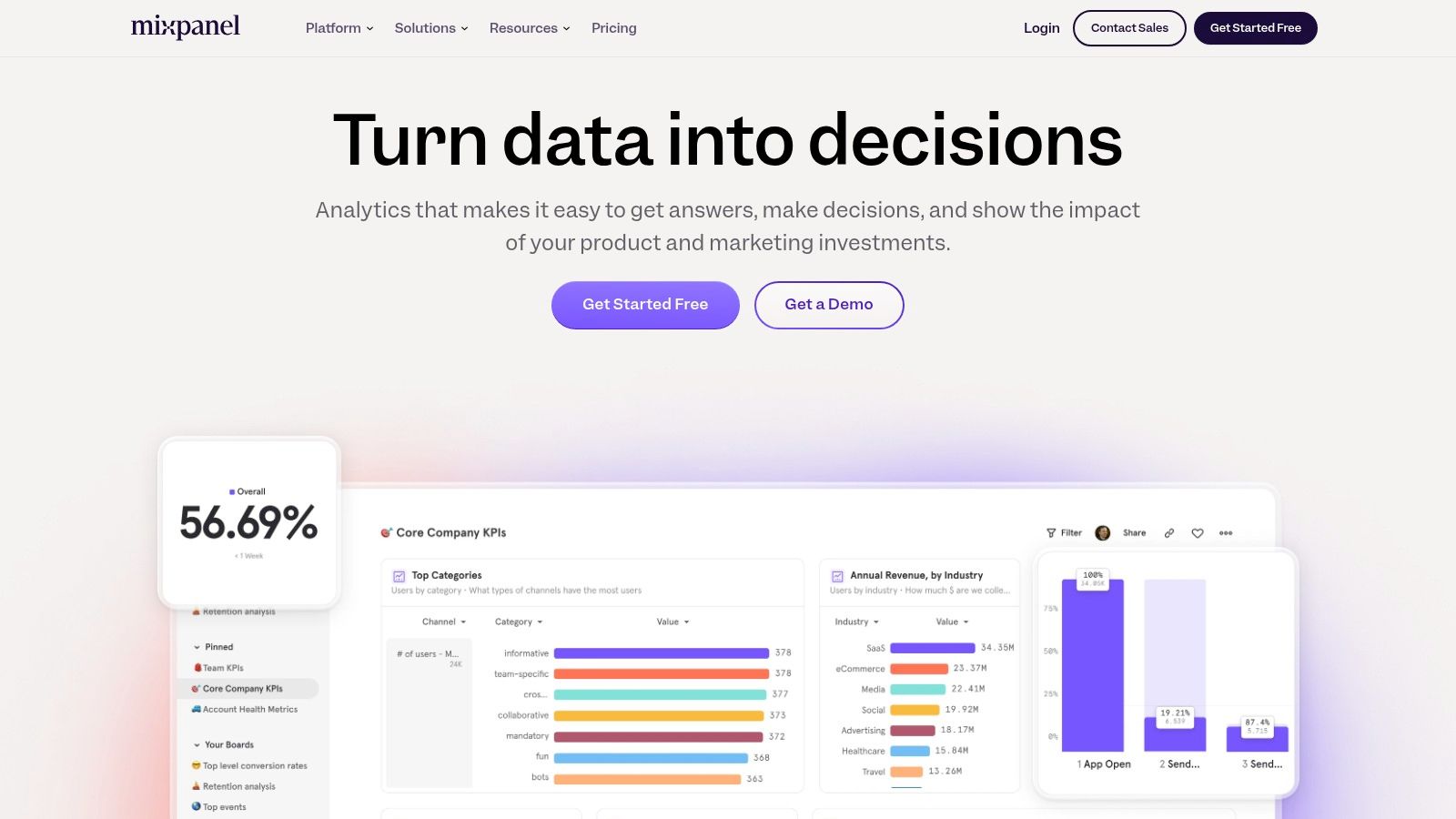
Mixpanel’s strength lies in its event-based tracking capabilities. This allows developers to meticulously track specific user actions within the application, such as button clicks, screen views, form submissions, and even custom defined events. This granular level of tracking provides valuable insights into user flows and behavior patterns, enabling product teams to identify bottlenecks, optimize conversion funnels, and personalize the user experience. For example, by tracking in-app purchase events and analyzing the steps leading up to a purchase, developers can identify friction points and optimize the checkout process to improve conversion rates. Furthermore, Mixpanel allows developers to attach custom properties to these events, providing even richer context and allowing for highly segmented analysis. This granularity is key to understanding not just what users are doing, but why they’re doing it.
The platform’s sophisticated cohort analysis and retention tracking capabilities allow developers to segment users based on shared characteristics and analyze their behavior over time. This is crucial for understanding user lifecycle, identifying high-value users, and developing targeted retention strategies. For example, a React Native game developer can analyze the retention rates of users who completed a specific tutorial level versus those who skipped it, revealing valuable insights into how onboarding impacts long-term engagement. A/B testing and feature flag management functionalities further enhance Mixpanel’s appeal, allowing developers to experiment with different versions of features and measure their impact on user behavior. This data-driven approach to development minimizes the risk of releasing poorly performing features and maximizes the potential for positive impact on key metrics.
Mixpanel shines with its intuitive interface and powerful querying capabilities, making it accessible to both technical and non-technical users. The robust React Native SDK, complete with TypeScript support, simplifies integration and allows for seamless data collection within React Native applications. Learn more about Mixpanel and best practices for application performance monitoring in relation to analytics platforms. While Mixpanel offers a generous free tier catering to up to 100,000 tracked users, it’s worth noting that costs can escalate for applications with larger user bases. Furthermore, mastering the advanced features, such as cohort analysis and user journey mapping, may require a learning curve. Lastly, while suitable for most reporting needs, customization options for enterprise-level reporting might be perceived as limited compared to some other specialized analytics platforms.
To integrate Mixpanel into your React Native application, you will need to install the Mixpanel React Native SDK via npm or yarn. Once installed, initialize the SDK with your project token, which you can obtain from your Mixpanel project dashboard. From there, you can begin tracking events and user properties using the provided API methods. Ensure you configure user identification carefully to leverage cross-platform tracking capabilities and maintain data consistency. This allows you to follow user journeys across different devices and platforms, providing a holistic view of user behavior. By effectively utilizing the React Native SDK and adhering to best practices, you can harness the full potential of Mixpanel for your React Native analytics needs.
4. Amplitude
Amplitude is a powerful product analytics platform specifically designed for mobile and web applications, including React Native. It goes beyond basic event tracking, offering sophisticated behavioral analytics, user journey analysis, and detailed insights into user engagement patterns. This makes it an excellent choice for product teams aiming to understand user behavior and optimize their React Native apps for growth. With its robust segmentation and retention analysis capabilities, Amplitude empowers you to pinpoint areas for improvement, personalize user experiences, and ultimately drive higher conversion rates. This comprehensive approach to React Native analytics is what sets Amplitude apart and earns it a place on this list.
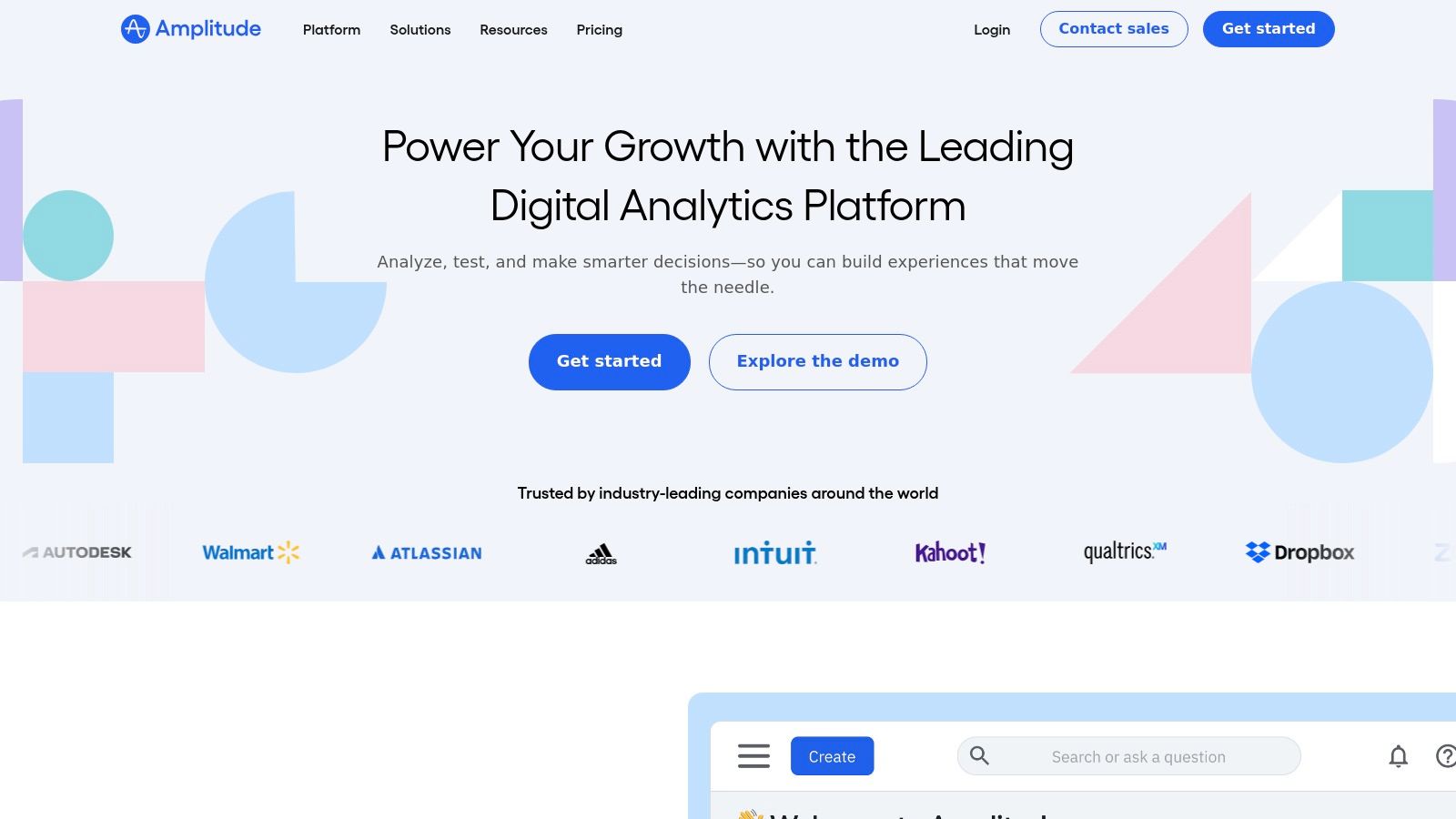
For React Native developers, understanding how users interact with their app is crucial. Amplitude’s React Native SDK provides the necessary tools to track key events, from initial app opens and feature usage to in-app purchases and churn. This granular level of data allows you to identify trends, understand user behavior, and make data-driven decisions. For instance, you could track the steps users take before making a purchase, identifying potential drop-off points in the conversion funnel. This information can then inform design and development decisions to streamline the user journey and improve conversion rates. Another practical application is analyzing user retention. Amplitude’s cohort analysis allows you to group users based on shared characteristics and track their behavior over time. This helps identify which user segments are most engaged and which are at risk of churning, allowing for targeted interventions and personalized engagement strategies.
Amplitude’s feature set is impressive. It includes behavioral cohort analysis, user journey mapping, advanced segmentation with custom user properties, funnel analysis and conversion optimization tools, predictive analytics, user lifetime value calculation, and real-time event validation and debugging tools. The platform’s advanced segmentation capabilities allow you to create highly specific user segments based on demographics, behavior, and other custom properties. This granularity enables you to personalize the user experience and target specific user groups with tailored content and promotions. Furthermore, its predictive analytics capabilities help anticipate user behavior and forecast future trends, allowing you to proactively address potential issues and capitalize on emerging opportunities.
While Amplitude’s free tier is generous, offering up to 10 million events per month, accessing the full suite of features requires a paid subscription. Pricing for the Growth and Enterprise plans is tailored to specific business needs and requires contacting their sales team. The Growth plan adds advanced features like collaboration tools and expanded data governance features. The Enterprise plan provides custom solutions including dedicated support, SLA guarantees, and advanced security features. This tiered pricing structure caters to a wide range of users, from startups to large enterprise organizations.
The React Native SDK is straightforward to implement, requiring the installation of the @amplitude/react-native package via npm or yarn. Detailed documentation is available on Amplitude’s website, guiding developers through the integration process. A key benefit of the SDK is its offline support, which allows events to be tracked even when the device is offline. These events are then synced automatically once the device regains connectivity. This ensures data integrity and provides a comprehensive view of user behavior, regardless of network conditions.
Compared to simpler analytics tools like Firebase Analytics, Amplitude offers significantly more sophisticated analysis capabilities. While Firebase provides basic event tracking and user demographics, Amplitude excels in providing deeper insights into user behavior and journeys. However, this power comes at a cost. Amplitude has a steeper learning curve than more basic tools, and its comprehensive feature set can be overwhelming for users with simpler analytics needs. Choosing the right tool depends on the specific requirements of your project and your team’s familiarity with analytics platforms. For teams seeking in-depth behavioral analytics and advanced segmentation, Amplitude is a valuable asset. For those looking for basic event tracking and user demographics, a simpler solution might be more appropriate. Regardless, for React Native analytics specifically targeted at product growth and in-depth user understanding, Amplitude is a strong contender.
5. Flurry Analytics
Flurry Analytics, Yahoo’s free mobile analytics platform, offers a comprehensive suite of tools for gaining insights into the performance of your React Native applications. It stands out for its mobile-first approach, easy integration, and detailed tracking capabilities, making it a valuable resource for developers seeking a free yet powerful analytics solution. Flurry’s focus on user behavior, crash reporting, and demographic analysis allows you to understand how users interact with your app, identify and fix critical issues, and tailor your strategies based on user characteristics. This makes it a strong contender for a place in any React Native developer’s toolkit.
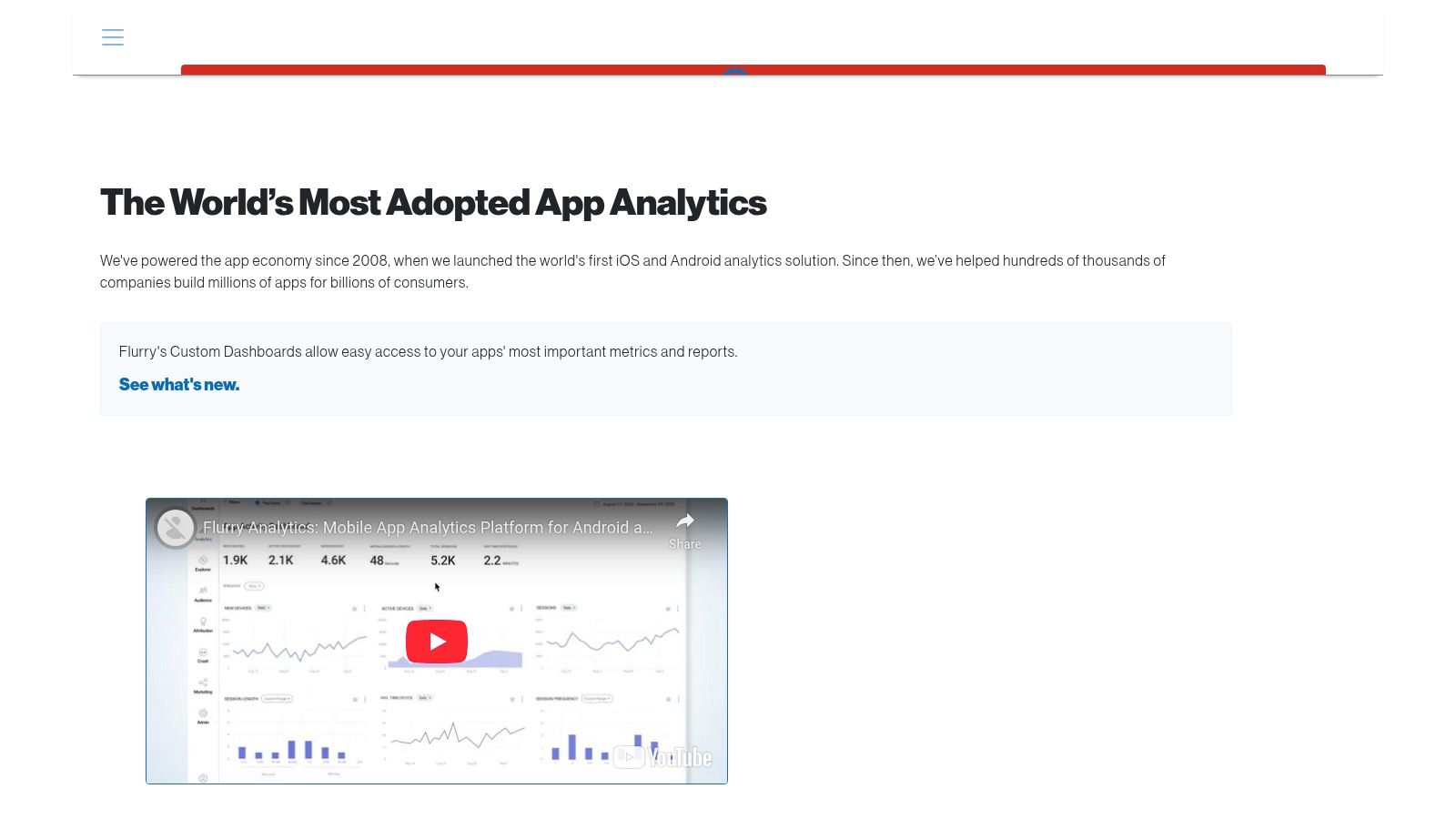
For React Native developers, understanding user behavior is paramount. Flurry provides detailed tracking of user journeys, allowing you to identify popular features, drop-off points, and areas for improvement within your app. This granular level of insight enables data-driven decisions regarding feature development and user experience optimization. For instance, you can track custom events, such as in-app purchases or button clicks, to understand which features resonate most with your users and optimize conversion funnels accordingly. Timed events further enhance this capability, allowing you to measure the duration of specific user interactions, such as the time spent on a particular screen or completing a specific task.
Crash and error reporting is another crucial aspect of app development, and Flurry excels in this area. It provides detailed crash reports with stack traces, enabling you to quickly identify the root cause of issues and implement effective fixes. This is invaluable for maintaining app stability and ensuring a positive user experience. Furthermore, the inclusion of push notification analytics allows you to measure the effectiveness of your notification campaigns and optimize their content and timing for maximum engagement. This comprehensive approach to performance monitoring helps streamline debugging and ensures a smooth, reliable app experience for your users.
A significant advantage of Flurry Analytics is its completely free tier with no limitations on the amount of data you can collect. This sets it apart from many competitors that often impose data limits or charge for access to advanced features. This makes Flurry an especially appealing option for indie developers and startups working with limited budgets. The simple setup and integration process further contributes to its ease of use, allowing developers to quickly integrate Flurry into their React Native projects without significant overhead.
While Flurry offers a compelling free analytics solution, it does have certain limitations. Compared to some premium analytics platforms, its advanced analytics features are somewhat limited. The dashboard customization options are also basic, which might restrict your ability to create highly tailored reports. Another point to consider is the ownership by Verizon Media, which raises some questions about the long-term support and development of the platform. You can Learn more about Flurry Analytics and other performance monitoring tools for React Native.
Despite these drawbacks, the benefits of a free, comprehensive analytics platform, particularly for smaller teams or early-stage projects, are undeniable. Flurry’s core features, coupled with its ease of integration and minimal impact on app size, make it a valuable tool for gaining essential insights into your React Native app’s performance. Whether you’re a seasoned developer or just starting with React Native, Flurry provides a solid foundation for understanding user behavior, tracking critical events, and ultimately, building better apps. The platform’s focus on mobile analytics ensures that you are equipped with the specific data you need to succeed in the mobile app landscape. If your primary requirements are essential analytics functionalities without the hefty price tag, Flurry Analytics is certainly worth considering. Visit the Flurry website for more information.
6. Adobe Analytics (Mobile SDK)
When your React Native application scales to enterprise levels and demands sophisticated analytics tailored for complex marketing attribution, Adobe Analytics (Mobile SDK) emerges as a powerful contender. While other React Native analytics tools cater to a broader range of project sizes, Adobe Analytics specifically targets large organizations that require in-depth analysis and a tight integration with their existing marketing ecosystem. This justifies its inclusion in our list, addressing the needs of a specific, high-demand segment of React Native app developers.
Adobe Analytics goes beyond basic event tracking and delves into intricate user behavior patterns. It provides enterprise-grade data processing capabilities and real-time reporting, empowering you to make data-driven decisions instantly. Imagine monitoring a crucial marketing campaign’s performance across different user segments as it unfolds. With Adobe Analytics, you can identify bottlenecks in the user journey, optimize conversion funnels, and react swiftly to changing market dynamics. This level of real-time granularity is rarely offered by other analytics solutions in the React Native space.
One of the key strengths of Adobe Analytics is its advanced attribution modeling. Unlike simpler analytics tools that might attribute conversions to the last click, Adobe allows for multi-touch attribution. This means you can accurately assess the contribution of various marketing channels and touchpoints throughout the user’s conversion journey. For example, you can understand the role of social media campaigns, email marketing, and in-app promotions in driving app installs and purchases. This complex analysis enables a more strategic allocation of marketing resources and a clearer understanding of ROI.
The tool’s customization capabilities are extensive. You can track custom variables with processing rules, tailoring data collection to your specific business requirements. This level of flexibility is crucial for large organizations with unique data tracking needs. Furthermore, seamless integration with Adobe Experience Cloud brings all your marketing efforts under one roof, allowing for a holistic view of the customer journey across different platforms and channels.
From a technical standpoint, the Adobe Analytics Mobile SDK offers comprehensive API access, allowing developers to implement custom integrations and leverage the full power of the platform. This makes it particularly attractive for developers working on large, complex React Native projects where out-of-the-box solutions often fall short.
However, the power and sophistication of Adobe Analytics come at a cost – literally. This solution is significantly more expensive than other React Native analytics tools, and its pricing model typically caters to enterprise-level budgets. Smaller to medium-sized applications will likely find the cost prohibitive and its feature set overkill. The setup and configuration process can also be complex, demanding specialized expertise and potentially a longer implementation timeline. The learning curve is steep, and developers will need to invest considerable time and effort to master the platform.
For those considering Adobe Analytics, understanding the technical prerequisites is essential. The SDK requires integration with the Adobe Experience Cloud, which adds another layer of complexity to the setup. Developers should be comfortable working with APIs and have experience with complex data structures. Familiarity with other Adobe marketing cloud products is a plus.
Compared to simpler analytics tools like Firebase Analytics or Segment, Adobe Analytics offers significantly more powerful features but demands a higher investment in terms of cost, implementation effort, and ongoing maintenance. While Firebase and Segment might suffice for basic event tracking and user behavior analysis, Adobe Analytics caters to the unique needs of enterprise organizations that prioritize sophisticated marketing attribution, real-time reporting, and seamless integration within the Adobe ecosystem.
If your organization requires enterprise-grade analytics and you’re prepared to invest the resources, Adobe Analytics offers an unparalleled level of depth and insight. For smaller projects or those with less demanding analytics requirements, exploring alternative tools might be more appropriate. You can learn more about Adobe Analytics (Mobile SDK) on their website: https://business.adobe.com/products/analytics/mobile-marketing-analytics.html
Implementing Adobe Analytics effectively within a React Native environment requires meticulous planning and execution. Here are a few tips to streamline the process:
- Plan your tracking strategy: Define clear objectives and identify the key metrics you want to track before diving into implementation.
- Leverage the Adobe documentation: Adobe provides extensive documentation and resources to guide you through the integration process.
- Start with a phased rollout: Implement basic tracking first and gradually add more advanced features as needed.
- Test thoroughly: Rigorous testing is crucial to ensure accurate data collection and reporting. Leverage Adobe’s debugging tools to identify and resolve any issues.
- Invest in training: Consider training your team on Adobe Analytics to maximize the value of the platform.
By carefully considering these factors and investing in the necessary resources, you can harness the power of Adobe Analytics to gain deep insights into your React Native application’s performance and drive data-driven decision-making within your organization.
7. Countly
Countly distinguishes itself in the crowded React Native analytics landscape by prioritizing data privacy and control. This open-source platform offers both cloud-hosted and on-premise deployment options, giving developers complete ownership of their app’s data. This is particularly appealing for organizations with strict data governance requirements, those operating in privacy-sensitive industries like healthcare or finance, and developers who simply prefer knowing exactly where their data resides. Countly’s focus on privacy makes it a powerful tool for achieving GDPR compliance, offering peace of mind in a regulatory landscape increasingly concerned with user data protection. For developers seeking robust React Native analytics coupled with granular control, Countly presents a compelling solution.
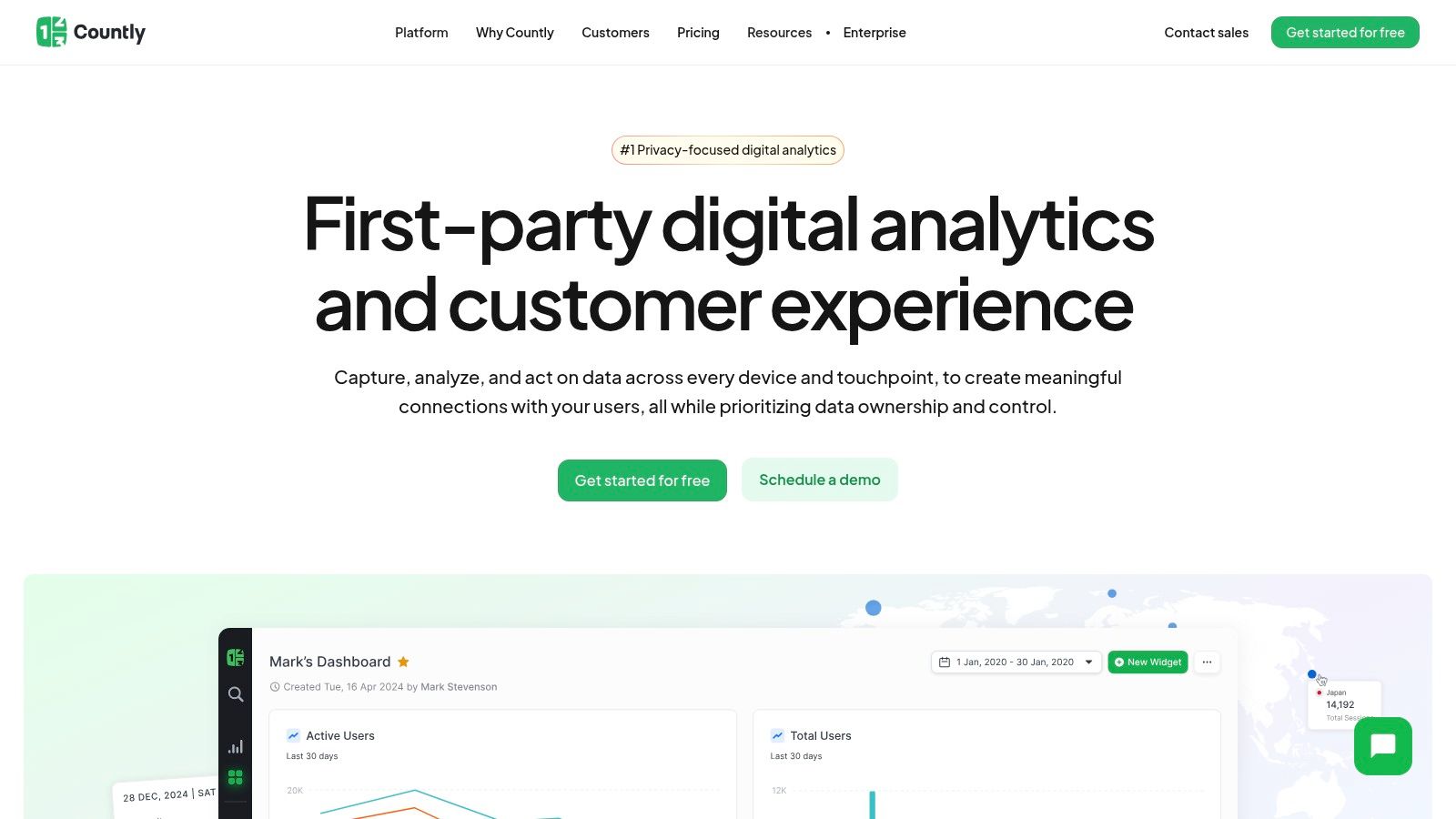
Countly’s comprehensive feature set goes beyond basic event tracking. It empowers developers to collect custom metrics, monitor app performance, and diagnose crashes effectively. Furthermore, Countly offers push notification analytics and campaign management, enabling data-driven optimization of user engagement. This integrated approach simplifies workflows by consolidating crucial app management functions within a single platform. This makes Countly a valuable asset not just for analysts, but also for DevOps teams, product managers, and anyone involved in improving the app’s performance and user experience.
The platform offers a real-time analytics dashboard, allowing developers and product managers to monitor key app metrics and identify emerging trends quickly. This real-time visibility is invaluable for rapid iteration and data-driven decision making. For example, product managers can use this data to assess the effectiveness of new features, and DevOps engineers can quickly identify performance bottlenecks. This responsiveness helps ensure the best possible experience for end users.
While Countly offers a free community edition, its more advanced features, like extended storage and enhanced support, are available through paid plans. The cloud-hosted option provides hassle-free setup and maintenance, while the on-premise solution caters to organizations with stringent data control needs. The pricing is transparent and scales with usage, making it adaptable to a wide range of budgets and project scopes.
Setting up Countly for a React Native application involves integrating the Countly SDK, configuring event tracking, and setting up the server (for self-hosted instances). The process requires a certain level of technical expertise, particularly for on-premise deployments. While the open-source nature of Countly benefits from community support, the documentation can sometimes fall short compared to commercially backed platforms. Furthermore, the UI/UX, although functional, isn’t as polished as some of the commercial alternatives available. A potential deployment strategy for larger applications that want robust data and deployment management could be Blue/Green deployment – even further solidifying release reliability and uptime. Learn more about Countly with this strategy.
Comparing Countly with alternatives like Firebase, Mixpanel, or Amplitude reveals its distinct strengths and weaknesses. While Firebase excels with its ease of use and extensive third-party integrations, Countly shines in data privacy and ownership. Mixpanel and Amplitude offer more sophisticated user segmentation and behavioral analysis tools but come with higher price tags and less control over data. Therefore, choosing the right analytics platform ultimately depends on specific project needs and priorities.
For React Native developers concerned about data privacy, operating under strict regulatory constraints, or simply prioritizing data ownership, Countly provides a robust and flexible analytics solution. While the self-hosted option requires technical expertise and the UI could benefit from further refinement, the open-source nature, coupled with a strong focus on privacy and GDPR compliance, makes Countly a worthy contender in the React Native analytics space. It particularly suits security-conscious enterprise organizations, QA and beta testing teams demanding granular data, and product managers seeking real-time insights while retaining full control over their app’s data. This unique blend of features and focus makes Countly a valuable tool for any React Native project where data privacy and control are paramount.
8. App Center Analytics (Microsoft)
App Center Analytics offers a robust yet simple solution for gathering crucial insights into your React Native application’s performance and user behavior. It provides a comprehensive suite of features, including automatic crash reporting, custom event tracking, and user demographics, allowing you to understand how users interact with your app and identify areas for improvement. While it offers a generous free tier, it’s important to be aware of its impending deprecation in March 2025, a factor that heavily influences its position on this list. Despite this, it remains a valuable tool for developers already integrated into the Microsoft ecosystem, particularly for those seeking a quick and easy setup for basic analytics. It provides actionable data to help enhance user engagement, troubleshoot issues, and ultimately improve the overall quality of your React Native application. It particularly shines when combined with other App Center services, offering a streamlined workflow for development and distribution.
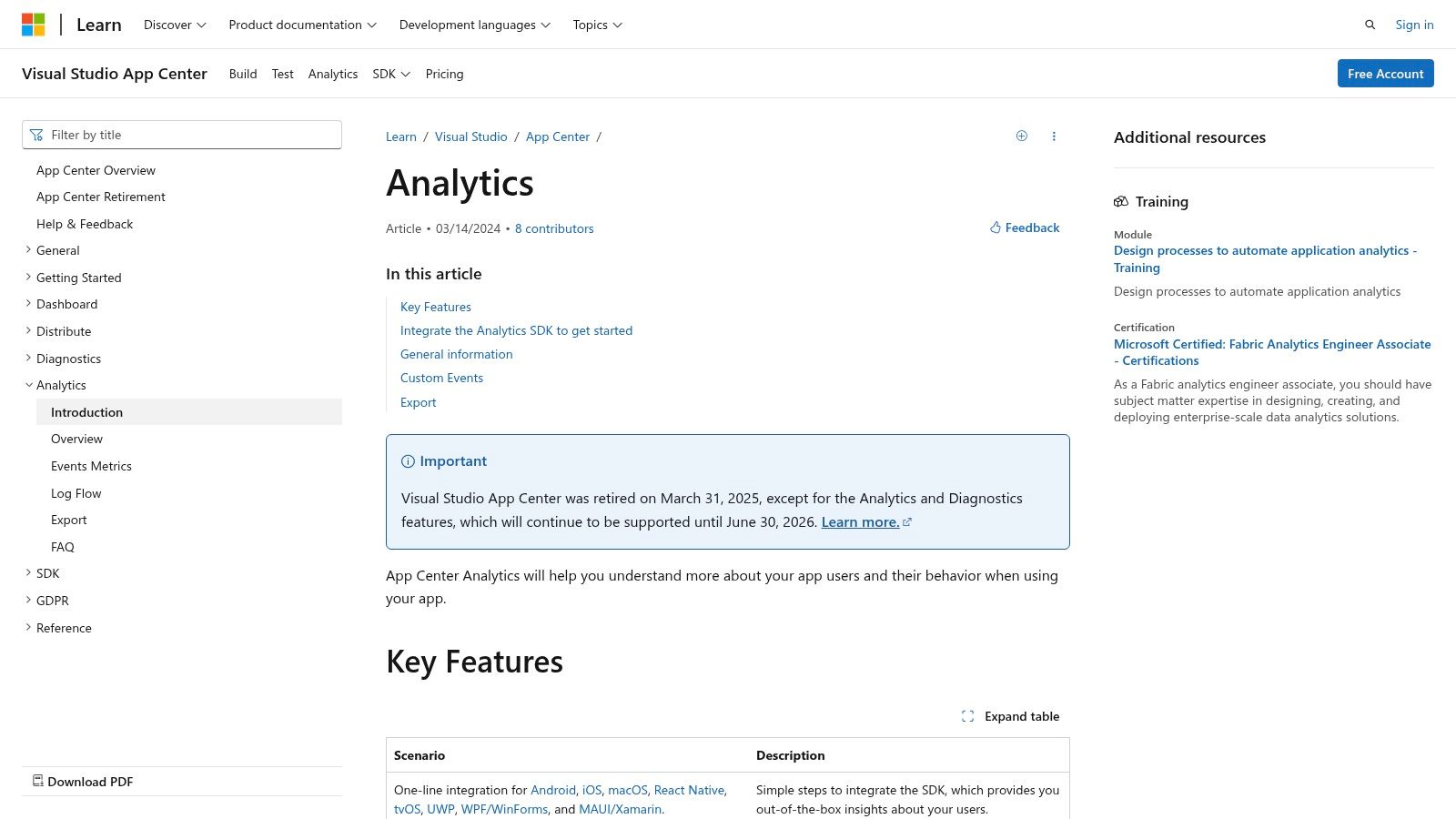
One of App Center Analytics’ most valuable features is automatic crash detection and symbolication. This feature significantly reduces debugging time by automatically capturing crash reports, including detailed stack traces, and symbolizing them to pinpoint the exact location of errors in your code. This allows developers to identify and address critical issues quickly, leading to a more stable and reliable app experience for users. Furthermore, the integration with App Center Distribute and Push simplifies the process of distributing beta versions and pushing updates to testers, creating a seamless workflow for testing and release management. This integration, combined with analytics, offers a powerful combination for managing the entire app lifecycle. If you’re looking for a CI/CD pipeline integration example with App Center, you might want to Learn more about App Center Analytics (Microsoft).
Custom event tracking is another powerful capability, allowing you to instrument specific events within your application. By defining custom events with properties and measurements, you can gain granular insights into user behavior and track key metrics related to specific features or user flows. For example, you could track events like in-app purchases, level completions in a game, or button clicks, providing valuable data to understand user engagement and optimize app design. This data, combined with user and session analytics, including device information, paints a comprehensive picture of your user base and their interactions with your app. Understanding which devices are most popular among your users can inform development decisions and prioritization of device-specific optimizations.
For teams heavily invested in the Microsoft ecosystem, App Center Analytics provides excellent integration with other Microsoft development tools. This seamless integration simplifies the development workflow, allowing for efficient data sharing and analysis. Export capabilities to Application Insights and other services further enhance the flexibility of the platform, enabling deeper analysis and integration with existing reporting infrastructure. While the free tier offers a generous range of features, opting for paid services unlocks advanced features and enterprise support, catering to the needs of larger organizations.
However, the impending deprecation of App Center Analytics in March 2025 presents a significant challenge. Developers using this service will need to migrate to alternative solutions before the deadline, introducing a disruption to existing workflows. While Microsoft has yet to provide detailed migration guidance, it’s a crucial factor to consider when evaluating this tool. Furthermore, when compared to some other React Native analytics solutions, App Center Analytics’ advanced analytics features are somewhat limited. Dashboard customization options are also basic, potentially restricting the ability to create highly tailored visualizations. These limitations, combined with the upcoming deprecation, may push some developers towards alternative solutions with more long-term stability and advanced feature sets. Despite these drawbacks, App Center Analytics remains a viable option for developers looking for a simple and easy-to-use analytics solution, especially if they are already within the Microsoft ecosystem. It provides valuable insights for improving app performance and understanding user behavior, offering a solid foundation for data-driven decision-making, particularly within the context of its remaining lifespan.
React Native Analytics Tools Comparison
| Platform | Core Features & Security | User Experience & Analytics | Value & Pricing | Target Audience | Unique Selling Points |
|---|---|---|---|---|---|
| 🏆 CodePushGo | Instant OTA updates, E2E encryption, smart diff ✨ | Real-time analytics, 1-click rollback ★★★★★ | 💰 One-time $2,600 setup, cost-saving long-term | 👥 React Native devs, DevOps, PMs | Flexible hosting, CI/CD & API integration, vendor-neutral |
| Google Analytics for Firebase | Unlimited free reporting, auto event tracking | Real-time data, strong React Native SDK ★★★★ | 💰 Free | 👥 All React Native apps | Seamless Firebase integration, free unlimited usage |
| Mixpanel | Event tracking, A/B testing, cohorts | Intuitive UI, real-time alerts ★★★★ | 💰 Free tier up to 100K users, can be costly | 👥 Product teams, growth hackers | Advanced behavioral analytics, feature flags |
| Amplitude | Behavioral cohorts, funnel optimization | Sophisticated visualization ★★★★ | 💰 Free tier (10M events/mo), premium features priced | 👥 Enterprise product teams | Predictive analytics, offline SDK support |
| Flurry Analytics | Free unlimited analytics, crash reporting | Simple setup, reliable crash data ★★★ | 💰 Completely free | 👥 Mobile-first apps, small teams | Demographic insights, push notification analytics |
| Adobe Analytics (Mobile SDK) | Enterprise reporting, advanced attribution | Real-time reporting, complex ★★★ | 💰 Very expensive, enterprise-only | 👥 Large organizations | Adobe Experience Cloud integration, marketing analytics |
| Countly | Open-source, GDPR compliance, crash & performance | Real-time dashboard, privacy-focused ★★★ | 💰 Free community edition, paid cloud/on-prem | 👥 Privacy-conscious orgs, self-hosters | Full data ownership, flexible deployments |
| App Center Analytics (MS) | Crash detection, custom events, device data | Reliable crash reports ★★★ | 💰 Free tier, retiring March 2025 | 👥 Microsoft ecosystem users | Easy setup, integration with App Center tools |
Making Data-Driven Decisions: Your Next Steps with React Native Analytics
Implementing effective React Native analytics is paramount to understanding your app’s performance and user behavior. From crash reporting and user engagement metrics to real-time insights and custom event tracking, the tools discussed in this article – CodePushGo, Google Analytics for Firebase, Mixpanel, Amplitude, Flurry Analytics, Adobe Analytics, Countly, and App Center Analytics – offer a range of powerful features to help you make data-driven decisions. The key takeaway is that selecting the right tool depends heavily on your specific needs and priorities.
Consider factors such as the scale of your app, your budget, the level of customization you require, and the specific data points you’re most interested in tracking. For example, if you’re a small startup with limited resources, a free solution like Firebase might be a good starting point. Larger enterprises with more complex requirements might benefit from the advanced features and robust reporting capabilities of platforms like Adobe Analytics or Mixpanel. Regardless of which tool you choose, ensure its seamless integration with your existing React Native development workflow and pay close attention to data privacy and security considerations.
By carefully evaluating these React Native analytics platforms and their respective strengths and weaknesses, you can equip yourself with the knowledge necessary to make informed decisions that propel your app towards success. To streamline your React Native development process further and gain valuable insights into your app’s performance, consider exploring CodePushGo. CodePushGo offers powerful features for managing React Native updates and analyzing performance data, complementing your chosen analytics tool. Visit CodePushGo to learn more and optimize your React Native development workflow.




